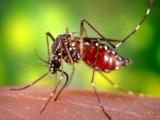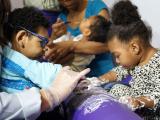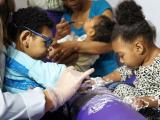Today the Centers for Disease Control and Prevention (CDC) released its plan to award $16 million to 40 states and territories as a stopgap measure to provide Zika funding while Congress is out of session.
In a press release, the CDC said the money will help develop and maintain systems to quickly identify and track microcephaly and other adverse health outcomes in babies born to mothers infected with Zika virus. The $16 million is in addition to the $25 million awarded on Jul 1 for Zika preparedness and response.
"It is critical to identify infants with birth defects related to Zika virus so we can support them and their families," said CDC Director Tom Frieden, MD, MPH, in the statement. "This CDC funding provides real-time data about the Zika epidemic as it unfolds in the United States and territories and will help those most devastated by this virus."
The announcement comes 1 day after the CDC issued a travel advisory regarding the Wynwood neighborhood of Miami, where 14 people were diagnosed as having Zika virus transmitted by local mosquitoes.
The CDC said the funds will also help support programs that will track the outcomes of children without microcephaly or obvious neurologic disease born to mothers who had Zika in pregnancy. In a news conference yesterday, Frieden said that undetected Zika infection in pregnancy may have unforeseen health outcomes for children.
The funds were appropriated based on each state's risk for Zika transmission and infections, and range from $200,000 to $720,000. Florida, California, New York, and Texas will each be awarded $720,000.
According to the CDC, the Department of Health and Human Services has spent more than $201 million of the $374 million redirected in April to fight Zika domestically.
Spotlight on long-term contraceptives
Meanwhile, in Mortality and Morbidity Weekly Report (MMWR) today, the CDC offered guidance on which contraceptive methods are most effective for women at risk for unintended pregnancies and provided data on recent contraception use in the country. Nearly half of all pregnancies in the United States are unplanned, and in light of Zika, the CDC said states should make every effort to make contraception widely available.
Zika infection in pregnancy can lead to microcephaly, vision problems, and a host of neurologic disorders in children.
"In the context of Zika preparedness, the full range of contraceptive methods approved by the Food and Drug Administration (FDA), including LARC, should be readily available and accessible for women who want to avoid or delay pregnancy," the study said.
The study said LARC, or long-acting reversible contraceptives (intrauterine devices and implants), are the most underused contraceptives among women at risk for unintended pregnancy. Between 2011 and 2015, only 5.5% to 30.5% of women targeted in four different surveillance systems reported regular use of LARC. In sexually active high school students, that percentage dropped to 1.7% to 8.4%.
The study authors suggested that LARC's high cost, limited provider training and reimbursement, and provider misconceptions contributed to its unpopularity.
"Increasing accessibility of contraceptive services, including LARC, can reduce unintended pregnancy, including the number of pregnancies affected by Zika virus infection among women who are returning, or whose partners are returning, from areas with ongoing Zika virus transmission," the authors concluded.
See also:
Aug 2 CDC press release
Aug 2 MMWR report




















